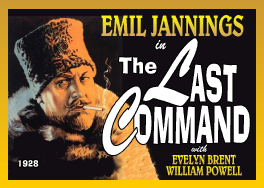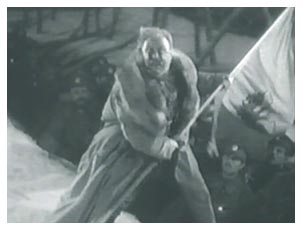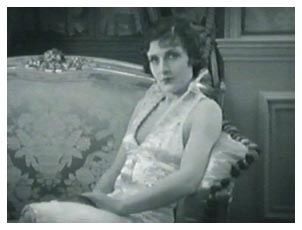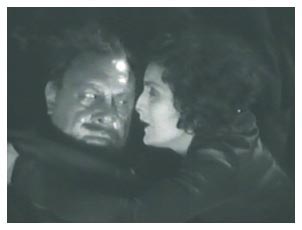

Distributed by Paramount
Directed by Josef von Sternberg
Release date: January 21, 1928
Cast: Emil Jannings (Grand Duke Sergius Alexander), Evelyn Brent
(Natalie), William Powell (Revolutionary/Director), Jack Raymond
(The Assistant), Nicholas Soussanin (The Adjutant), Michale Visaroff
(The Bodyguard), Fritz Feld (A Revolutionist)
Before viewing Director Josef von Sternberg's brilliant film The Last Command, one might consider these lines from William Butler Yeats' To a Friend Whose Work Has Come to Nothing:
The Last Command is concerned with such a character who has ascended to the highest possible point and then been struck down to a humiliating position: in short, one whose life's work has come to nothing. However, with director Josef von Sternberg at the helm, Emil Jannings in the leading role of Grand Duke Sergius Alexander, Evelyn Brent as the smoldering and selfless Natalie (or Natacha in older prints of the film), and William Powell as the Revolutionist Director, the film echoes with so much more than an (albeit brilliantly done) story of status and ruin; it widens its range into then-present Hollywood, with a commentary on Hollywood, a rumination on the nature of acting and power, and above all, the exploration of the very essence of a single man.
The film begins in Hollywood -- the Mecca of the World! -- in a Russian director's office, as the director and staff shuffle through photographs of extras. As the director raises an unlighted cigarette, a dozen matches flame up around him from his assistants; this motif of smoking and authority is explored again and again in this film. Suddenly, the director notices a face within the stack: an extra who claims to have been a Russian general. Something dawns on the director's face at this, and he orders one of his assistants that the General-extra be present on the lot the next day. Our first glimpse of Jannings is a haunting one: responding to his landlady's message from the studio, he slowly and nervously opens the door. Jannings' moustache is askew, and he has a hobbling step and ruinous face with a hopeless, forlorn expression. Perhaps most tellingly, his head shudders back and forth constantly, and his eyes are glazed and bleary, the gaze of a man who cannot accept what he sees.
The next shot opens with the Bread Line of Hollywood, the
gates of the studio that extras enter, and a long pan shot of
those hungry, bearded faces, contrasted with the Mecca of the
World not five minutes before. The gates open, and the crowds
rush forward: Jannings is jostled from side to side, especially
by a particularly irate extra, as he retrieves the necessary uniform
and accessories. Ironically, he has been called to be a general
in this film by the Russian director and is dressed accordingly.
The costume managers in these scenes are a sullen bunch; it's
quite clear from their disjointed and slow movements, as well as the looks they give extras like Janning,
that they could not care less about them. Jannings is pushed and
taunted down a similar line by mountains of caps, knapsacks, and
rifles. Once inside the dressing room, made somewhat uncomfortable
by the rows of bayonet tips around him, Jannings' shudder increases,
much to the annoyance of his fellow extras. On being asked why
he cannot stop shaking, Jannings gently replies that "I had
a great shock once," and gingerly removes a medal he claims
he received from the Czar. The surrounding extras, all Russian,
taunt him even more, forcing him to reclaim the medal from a high
bayonet tip. The final hammerfall comes when the utterly humiliated
Jannings looks into his makeup mirror and sees himself, a ruined
and shaking man, his shuddering seeming to say "No, this
can't be so." Upon this reflection, Jannings is borne back
into the past of 1917 Imperial Russia.
movements, as well as the looks they give extras like Janning,
that they could not care less about them. Jannings is pushed and
taunted down a similar line by mountains of caps, knapsacks, and
rifles. Once inside the dressing room, made somewhat uncomfortable
by the rows of bayonet tips around him, Jannings' shudder increases,
much to the annoyance of his fellow extras. On being asked why
he cannot stop shaking, Jannings gently replies that "I had
a great shock once," and gingerly removes a medal he claims
he received from the Czar. The surrounding extras, all Russian,
taunt him even more, forcing him to reclaim the medal from a high
bayonet tip. The final hammerfall comes when the utterly humiliated
Jannings looks into his makeup mirror and sees himself, a ruined
and shaking man, his shuddering seeming to say "No, this
can't be so." Upon this reflection, Jannings is borne back
into the past of 1917 Imperial Russia.
Throughout the rest of the film, an extended flashback of Jannings' previous life, certain images, gestures, and staging recur again and again. For example, the use of cigarettes -- already demonstrated by Powell in the first few minutes of the film -- takes on a powerfully expressive role, and one that, like so much in this film, is inverted ceaselessly. In our first view of Jannings as the Grand Duke, he takes a cigarette from his pocket and, with a light from his attendant, fastidiously and luxuriously smokes away. Here, he possesses power and status, reiterated again when he meets Powell as the revolutionary and slowly blows smoke into his face. Powell himself has a distinctive smoking manner: the cigarette is held between his third and ring fingers and swept back with a bit of flair, even after he has been thrown in prison by Jannings. However, Jannings' aide foreshadows his downfall when he smokes his cigarettes out of Jannings' sight and wears his fur coat. The downfall is made complete near the end of the flashback when Jannings, stripped of fur coat and beaten by a revolutionary mob, is forced by the selfsame aide to smoke: the ultimate humiliation for a generalissimo. Another tool used by von Sternberg is that of backgrounds. Some of these backgrounds could exist for purely aesthetic reasons; however, in several scenes they take on a much more expressive purpose. When Powell and Brent are being held in Jannings' headquarters, they sit in front of a large map of Russia; Jannings' desk is situated in front of the same map. The actors' movements in front of and around these maps serve to illustrate details of this political melodrama: specifically, they prove an answer to the question 'Who loves Russia most?' Finally, before Jannings is disgracefully forced to smoke his cigarettes (in a scene akin to Christ being taunted to prophesy during the Passion), he is hauled against a city wall with an alcove that contains a Russian ikon of a weeping king, with what looks to be manacled hands. It is the perfect image for the deposed Grand Duke.
The score for The Last Command, by Robert Israel,
is one of the most striking elements of the Criterion edition
of the film. As Israel himself observed, "Silent film is
really a misnomer" (On the Scores, included in the
Criterion booklet), and this particular score could almost be
a character in itself. Israel considered the film sweeping and
complex, and the music had to fit; what's more, the music  required copious research, as the
Bolshevik upheaval that took place eleven years before brought
about a change in the national anthem. For the purposes of the
film, and especially considering Jannings' character, Israel stayed
true to the original, as well as to many other traditional Russian
melodies. Beyond these melodies and anthems, the musical texture
is simply delicious, often going back and forth between Israel's
so-called "Love Theme" and "Despair Theme."
The former is relatively simple, involving harp and some light
strings, while the "Despair Theme" features a tragic
French horn line with a haunted piano and heavy strings accompanying.
However, the most powerful scene of the film may well be the last
three minutes: after Jannings' death on a Hollywood set (made
to look like a 1917 battlefield), the music completely drops away.
When I watched this film with a friend, chaos nearly ensued as
he snatched up the remote and attempted to turn up the volume
all the way, swearing that the DVD player had malfunctioned; after
two measures, light harp returns, but it's not often that a silent
film is completely silent. Many elements of the "Despair
Theme" are magnified at the finale, though the music itself
soars in the last measure into a hopeful phrase, underscoring
the flight of Jannings' spirit in the previous scene.
required copious research, as the
Bolshevik upheaval that took place eleven years before brought
about a change in the national anthem. For the purposes of the
film, and especially considering Jannings' character, Israel stayed
true to the original, as well as to many other traditional Russian
melodies. Beyond these melodies and anthems, the musical texture
is simply delicious, often going back and forth between Israel's
so-called "Love Theme" and "Despair Theme."
The former is relatively simple, involving harp and some light
strings, while the "Despair Theme" features a tragic
French horn line with a haunted piano and heavy strings accompanying.
However, the most powerful scene of the film may well be the last
three minutes: after Jannings' death on a Hollywood set (made
to look like a 1917 battlefield), the music completely drops away.
When I watched this film with a friend, chaos nearly ensued as
he snatched up the remote and attempted to turn up the volume
all the way, swearing that the DVD player had malfunctioned; after
two measures, light harp returns, but it's not often that a silent
film is completely silent. Many elements of the "Despair
Theme" are magnified at the finale, though the music itself
soars in the last measure into a hopeful phrase, underscoring
the flight of Jannings' spirit in the previous scene.
In 1941, John Agate named Emil Jannings as "one of
the world's greatest actors . . . is there any film actor living
today who is possessed of the sheer power of Jannings, who always
in his massivity reminded me of Richter's handling of Wagner?"
Jannings certainly resembles a thundercloud on screen, but as
far as The Last Command is concerned, the real power of
his performance is not simply in its massivity. Jannings plays
the arrogant Grand Duke, as well as the piteous Hollywood extra,
and is stunning in both expressions of the same character. His
ability to live the part, as George C. Pratt noted, is unparalleled.
In his autobiography, Fun in a Chinese Laundry, von Sternberg
reflects on Jannings' habit of bringing his work home. "On
days that Jannings played the extra, he scraped on the door meekly,
hoping that his servants would hear him; on the days of the Grand
Duke, he banged on the door, kicked it in, and lifted up the maids'
dresses with his swagger stick." In the film itself, he is
unforgettable as the submissive extra who shuffles mindlessly
through crowds, constantly shuddering, and whose eyes are unfocused
and bleary. As he essays the Grand
Duke, it is easy to discern what von Sternberg saw: "In a
measure, [Jannings' extreme shyness] had helped him to fame, for
he was known for his trick of expressing emotion with his back
turned to the camera, his back being more expressive than the
facial mimicry of most actors" (Fun in a Chinese Laundry).
When Jannings confronts the revolutionaries, the scenes of his
back are most extraordinary, as well as the scene in which Natalie
almost kills him. Moreover, Jannings is incredible in the scenes
directly following the torment of the mob: pressed against an
old city wall, and doused with blood, vodka, and spittle, his
expression is almost Christ-like. While some critics have spoken
against Jannings' performance for his lack of fury here, his despair
and resignation to humiliation are remarkably gripping. However,
the most stirring scene occurs at the end of the film, when Jannings,
dressed again as a Grand Duke in Hollywood, is made to play a
version of his former self on a set for a Russian war film. Much
like Norma Desmond in Sunset Boulevard, Jannings is swept
into delusion by the scene, the cameras, and even the Russian
national anthem that is playing. Believing himself the General
once more, his eyes widen as he urges on his 'troops' and waves
the Imperial flag in the man-made wind. The Director, William
Powell, is also clearly affected by these scenes, and a series
of crosscut shots underscore his pity. Finally, Jannings dies
in his exultation in Powell's arms, a truly joyous expression
and a single tear on his face for having made his life's work
come to fruition: he believes he has saved Russia. Though Jannings
begins the film as a meek Russian extra, he ends it with a thunderous
climax of joy and patriotic passion.
Grand
Duke, it is easy to discern what von Sternberg saw: "In a
measure, [Jannings' extreme shyness] had helped him to fame, for
he was known for his trick of expressing emotion with his back
turned to the camera, his back being more expressive than the
facial mimicry of most actors" (Fun in a Chinese Laundry).
When Jannings confronts the revolutionaries, the scenes of his
back are most extraordinary, as well as the scene in which Natalie
almost kills him. Moreover, Jannings is incredible in the scenes
directly following the torment of the mob: pressed against an
old city wall, and doused with blood, vodka, and spittle, his
expression is almost Christ-like. While some critics have spoken
against Jannings' performance for his lack of fury here, his despair
and resignation to humiliation are remarkably gripping. However,
the most stirring scene occurs at the end of the film, when Jannings,
dressed again as a Grand Duke in Hollywood, is made to play a
version of his former self on a set for a Russian war film. Much
like Norma Desmond in Sunset Boulevard, Jannings is swept
into delusion by the scene, the cameras, and even the Russian
national anthem that is playing. Believing himself the General
once more, his eyes widen as he urges on his 'troops' and waves
the Imperial flag in the man-made wind. The Director, William
Powell, is also clearly affected by these scenes, and a series
of crosscut shots underscore his pity. Finally, Jannings dies
in his exultation in Powell's arms, a truly joyous expression
and a single tear on his face for having made his life's work
come to fruition: he believes he has saved Russia. Though Jannings
begins the film as a meek Russian extra, he ends it with a thunderous
climax of joy and patriotic passion.
Director Josef von Sternberg is famed for his exquisite
use of light and dark: no, use implies an almost utilitarian purpose.
Some von Sternberg shots exist, and rightly so, for beauty alone.
He is also famed for his contrived sets and staging: there is
not a hint of realism within most of his films. The Last Command,
however, "represents a transitory stage, a compromise between
stylized realism and the self-contained world of von Sternberg
films" (Brownlow, The Parade's Gone By). The film
contains several scenes that are simply beautiful in shadow and
construction, and, when talking about a von Sternberg film, one
might begin with the female lead: Evelyn Brent. Von Sternberg
was a regular at the Altar of The Female in Repose, and no one
lounges as magnificently as Evelyn Brent: there are five separate
repose scenes in The Last Command, each carrying significant
weight. For example, there is a scene in which Jannings is flirting
with Brent, who is curled up in a chair at Headquarters, swathed
in dark fox furs and curling smoke. The lighting is exceptional,
radiantly accentuating all the curves and corners of Brent's face
amidst the shadows of fur  and smoke.
In fact, von Sternberg uses an effective combination of close-ups
and panorama shots (used very well with all the mob scenes in
the film) throughout The Last Command: his close-ups of
the ruined Jannings and the brooding Powell are some of the most
powerful in the film. However, there is one sequence in the film
that rises far above in the realm of shadow and construction:
after beating Jannings, the revolutionary mob decides (at the
suggestion of Brent) to make him stoke the train to Petrograd,
where he will be hanged. Brent suggests this to give Jannings
a chance to escape on the train, and then climbs over the train
to the front, where Jannings is being abused by the former stoker.
The atmosphere is hellish: fire boils forth from a circular door
and wicked-looking chains hang from the ceiling, appearing in
most of the scenes to imprison Jannings. The scene bears some
similarities with the initial sequences of the boiler room in
The Docks of New York: however, while the stokers in Docks
stoked their own lust as they came into port, Jannings is stoking
his own defeat and humiliation, coal by coal. Clad in black but
for a string of pearls, Brent climbs over a mountain of coals
and declares her love for Jannings, giving him the pearls to get
out of Russia. All these scenes are illumined by the coal-fire,
the shadows underscoring the blood and wrinkles on Jannings' face,
the anxiety in Brent's expression, and the violence of the abusive
stoker. Finally, while Brent distracts another revolutionary,
Jannings attacks the stoker and leaps from the train, only to
watch the train and Natalie crash off a bridge and into an icy
lake. As the final curl of smoke disappears, his head begins to
shudder, and his eyes go blank with loss and despair.
and smoke.
In fact, von Sternberg uses an effective combination of close-ups
and panorama shots (used very well with all the mob scenes in
the film) throughout The Last Command: his close-ups of
the ruined Jannings and the brooding Powell are some of the most
powerful in the film. However, there is one sequence in the film
that rises far above in the realm of shadow and construction:
after beating Jannings, the revolutionary mob decides (at the
suggestion of Brent) to make him stoke the train to Petrograd,
where he will be hanged. Brent suggests this to give Jannings
a chance to escape on the train, and then climbs over the train
to the front, where Jannings is being abused by the former stoker.
The atmosphere is hellish: fire boils forth from a circular door
and wicked-looking chains hang from the ceiling, appearing in
most of the scenes to imprison Jannings. The scene bears some
similarities with the initial sequences of the boiler room in
The Docks of New York: however, while the stokers in Docks
stoked their own lust as they came into port, Jannings is stoking
his own defeat and humiliation, coal by coal. Clad in black but
for a string of pearls, Brent climbs over a mountain of coals
and declares her love for Jannings, giving him the pearls to get
out of Russia. All these scenes are illumined by the coal-fire,
the shadows underscoring the blood and wrinkles on Jannings' face,
the anxiety in Brent's expression, and the violence of the abusive
stoker. Finally, while Brent distracts another revolutionary,
Jannings attacks the stoker and leaps from the train, only to
watch the train and Natalie crash off a bridge and into an icy
lake. As the final curl of smoke disappears, his head begins to
shudder, and his eyes go blank with loss and despair.
The Last Command is a film of many layers and inversions. Enemies become lovers and friends, authority is supplanted multiple times, and the past becomes the present. Throughout all of this, one might wonder: what is The Last Command? A diatribe against Hollywood's treatment of film extras? A romantic-political melodrama? An immense and sweeping character study? Many critics consider it a star vehicle for Emil Jannings; James Card writes in Seductive Cinema that "if ever there was a magnificent opportunity for an actor of gargantuan talent to exhibit vast skill, that superrole was created in the script of The Last Command." Josef von Sternberg commented in his autobiography that "it [the story] interested me very much, as I saw an opportunity to deal with the machinery of Hollywood and its treatment of the film extra." By itself, the flashback narrative lends itself to a character study and especially a romantic-political drama; however, by framing the flashback within a later narrative, von Sternberg creates a very different sort of film that relies upon these elements to investigate not only Hollywood, but the nature of acting itself and its effect on Jannings. Both literally and within the context of the plot, there is hardly a single moment in the film when someone is not acting, and, as Anton Kaes writes, "The Last Command is filled with the elusive and maddening inter-twining of life and fiction that acting requires" (Illusions and Delusions, Criterion booklet). In the end, the film's grand task is to explore the magic and danger that come with the double identities (for instance, Jannings plays both an extra and that same extra playing a version of his former self) of acting, film or otherwise. With moving performances by Emil Jannings, Evelyn Brent, and William Powell, as well as exquisite 'paintings' of light and dark and an exceptional score, The Last Command will take you into the midst of revolution, love, subterfuge, violence, and double identities: the only order must be 'forward!'